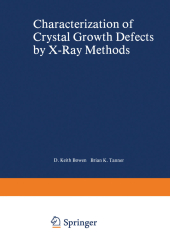 Neuerscheinungen 2012Stand: 2020-01-07 |
Schnellsuche
ISBN/Stichwort/Autor
|
Herderstraße 10
10625 Berlin
Tel.: 030 315 714 16
Fax 030 315 714 14
info@buchspektrum.de |

Brian K. Tanner
Characterization of Crystal Growth Defects by X-Ray Methods
1980. 2012. xxvi, 589 S. 556 SW-Abb. 254 mm
Verlag/Jahr: SPRINGER, BERLIN 2012
ISBN: 1-475-71128-X (147571128X)
Neue ISBN: 978-1-475-71128-8 (9781475711288)
Preis und Lieferzeit: Bitte klicken
This book contains the proceedings of a NATO Advanced Study Institute entitled "Characterization of Crystal Growth Defects by X-ray Methods´ held in the University of Durham, England from 29th August to 10th September 1979. The current interest in electronic materials, in particular silicon, gallium aluminium arsenide, and quartz, and the recent availability of synchrotron radiation for X-ray diffraction studies made this Advanced Study Institute particularly timely. Two main themes ran through the course: 1. A survey of the various types of defect occurring in crystal growth, the mechanism of their different methods of generation and their influence on the properties of relativelY perfect crystals. 2. A detailed and advanced course on the observation and characterization of such defects by X-ray methods. The main emphasis was on X-ray topographic techniques but a substantial amount of time was spent on goniometric techniques such as double crystal diffractometry and gamma ray diffraction. The presentation of material in this book reflects these twin themes. Section A is concerned with defects, Section C with techniques and in linking them. Section B provides a concise account of the basic theory necessary for the interpretation of X-ray topographs and diffractometric data. Although the sequence follows roughly the order of presentation at the Advanced Study Institute certain major changes have been made in order to improve the pedagogy. In particular, the first two chapters provide a vital, and seldom articulated, case for the need for characterization for crystals used in device technologies.
1 Industrial Implications of Crystal Quality.- 2 The Technical Importance of Growth Defects.- 3 Defects and their Detectability in Melt-Grown Crystals.- 4 Defects and Their Detectability.- 5 Defect Generation in Metal Crystals.- 6 Defects in Non-metal Crystals.- 7 Defect Visualisation: Individual Defects.- 8 Experimental Techniques for the Study of Statistically Distributed Defects.- 9 Elementary Dynamical Theory.- 10 Perfect and Imperfect Crystals.- 11 X-ray Sources.- 12 X-ray Detectors.- 13 Sample Preparation.- 14 Laboratory Techniques for X-ray Reflection Topography.- 15 Laboratory Techniques for Transmission X-ray Topography.- 16 White Beam Synchrotron Radiation Topography.- 17 Control of Wavelength, Polarization, Time-Structure and Divergence for Synchrotron Radiation Topography.- 18 Monochromatic Synchrotron Radiation Topography.- 19 Environmental Stages and Dynamic Experiments.- 20 Technology and Costs of X-Ray Diffraction Topography.- 21 X-Ray TV Imaging and Real-Time Experiments +.- 22 Computer Modelling of Crystal Growth and Dissolution.- 23 Microradiography and Absorption Microscopy.- 24 Reciprocal Lattice Spike Topography.- 25 Reflection Topography: Panel Discussion.- Appendix I Designing a Topographic Experiment.- Appendix 2 Defects and Artifacts.- Appendix 3 Exercises in Diffraction Contrast.- Appendix 4 Stereographic Projection Description for X-Ray Topography: Subgrain Boundaries and Stereo-Pairs.- Appendix 5 Dispersion Surface Exercises.- Appendix 6 Contrast of Stacking Faults.- Appendix 7 Misfit Boundaries and Junctions of Purely Rotational Boundaries.- Sponsors, Organising Committee, Advisory Panel.- Chemical Formula Index.


